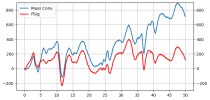What version of the code are you using?
CESM 2.1.5 on Derecho
Have you made any changes to files in the source tree?
No.
Describe every step you took leading up to the problem:
Diagnose half-hourly output of F2000 (FV, 2deg)
Describe your problem or question:
Hi,
I am doing some simple calculation using half-hourly output of U,V,PS,PRECT,LHFLX to verify the conservation of mass in model.
I selected a small domain (~10degx10deg) over the North Pacific Ocean during Jan to Feb (about 50 days), computed the divergence of vertically integrated mass flux, and compared it with the change of total mass (PS/g). The mass on each grid and each level is calculated based on PS, hyai, and hybi on each timestep, and cos lat is considered when calculating the flux and area average. All values are calculated in per unit area.
As shown in the first figure, it is clear that the surface pressure decreases when the flow diverge and vise versa. Moisture processes given by precipitation (1000*PRECT as kg/s) and surface latent flux (LHFLX/2.3e6 as kg/s) make little change to the mass convergence. However, after integrating the mass convergence from the first timestep and comparing it with the change of PS with respect to the first timestep, a significant departure happens as shown in the second figure. The total mass increases by about 120 kg in 50 days while the mass change due to mass convergence is over 600 kg.
I know that bias may occur due to various reasons, such as if the value is on the edge or center of grid. But I am wondering if an exact mass conservation can be expected in CAM output or my calculation is the correct way to verify the mass conservation.
Thanks
Fucheng
CESM 2.1.5 on Derecho
Have you made any changes to files in the source tree?
No.
Describe every step you took leading up to the problem:
Diagnose half-hourly output of F2000 (FV, 2deg)
Describe your problem or question:
Hi,
I am doing some simple calculation using half-hourly output of U,V,PS,PRECT,LHFLX to verify the conservation of mass in model.
I selected a small domain (~10degx10deg) over the North Pacific Ocean during Jan to Feb (about 50 days), computed the divergence of vertically integrated mass flux, and compared it with the change of total mass (PS/g). The mass on each grid and each level is calculated based on PS, hyai, and hybi on each timestep, and cos lat is considered when calculating the flux and area average. All values are calculated in per unit area.
As shown in the first figure, it is clear that the surface pressure decreases when the flow diverge and vise versa. Moisture processes given by precipitation (1000*PRECT as kg/s) and surface latent flux (LHFLX/2.3e6 as kg/s) make little change to the mass convergence. However, after integrating the mass convergence from the first timestep and comparing it with the change of PS with respect to the first timestep, a significant departure happens as shown in the second figure. The total mass increases by about 120 kg in 50 days while the mass change due to mass convergence is over 600 kg.
I know that bias may occur due to various reasons, such as if the value is on the edge or center of grid. But I am wondering if an exact mass conservation can be expected in CAM output or my calculation is the correct way to verify the mass conservation.
Thanks
Fucheng


